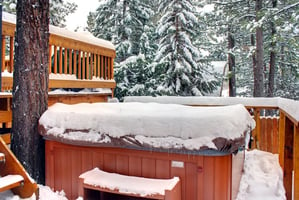You are missing out if you think hot tubbing is only for warm weather. Soaking in a hot tub during...
Maintaining a Foam-Free Hot Tub: Best Practices for Owners
Hot tub foam is one of the most common issues that owners encounter. While some foam is normal and to be expected, excessive foam can diminish your soaking experience. We have assembled some of the best practices and solutions for owners to help maintain a foam-free hot tub.
What causes hot tub foam
While there are many reasons why a hot tub will suddenly foam up, the number one reason is us. We use deodorant, body sprays, lotions, soap, and shampoo daily. In addition, we wash our swimsuits with laundry detergent and fabric softeners.
Another contributing factor is how we take care of our hot tubs. Poor water chemistry and maintenance contribute to poor water quality and foamy water.
Phase One-Steps for Initial fill or water change
Battling Hot Tub Foam Starts On Day One. The best way to minimize any problem with your hot tub is with a good start-up. Whether your water is directly from the tap or well water or you have it trucked in.
We have outlined tips for successfully preparing your water for that relaxing soak you have been waiting for.
If your hot tub is brand new from the factory. You may consider filling and draining it. Your new hot tub was wet-tested before it was shipped and will have residual water in the lines. Depending on the water and how long it has sat before it was delivered, this could avoid problems right from the start.
Get to know your water by testing it and recording the results before you fill your hot tub. This will give you a baseline, and you will know what changes to make at each water change. I would also recommend keeping a log of your results and the steps you took to resolve them.
Balancing your water is not an option. It is a must. Low alkalinity and low water hardness are both causes of foam in a hot tub, and your sanitizer will be less effective. For a typical hot tub, alkalinity should be between 80-120 parts per million, and most hot manufacturers and spa chemical companies recommend a water hardness level between 150-250. Be sure to check your hot tub manual and the sanitizer label. If you are using a salt system, they usually work at a much lower hardness level of 25-75 ppm.
When adding any chemicals, your cover should be off, pumps should be on and running on high, and water features should also be on. If your hot tub has diverters, they should be in the middle position or full flow position, and any air intakes, also known as air mix, should be off whether you are adding a powder or liquid. I suggest introducing those chemicals near the filter area and letting the pump run for 10 minutes. Remember to turn your water feature off when you are done to prevent water from leaking out of the tub when the cover is closed.
If water quality is poor or minerals are present, use a pre-filter for your hose when filling the hot tub. This will remove unwanted contaminants that could cause a water imbalance, which will take time to adjust before you can use your hot tub.
After the hot tub is filled and the water is balanced, add the recommended amount of bromine or chlorine. The label should have the amount based on your hot tub size. This step will help with any containments in the plumbing from a previous fill included from the factory and give you peace of mind that your hot tub water is healthy.
Phase Two-Regular Maintenance
Maintaining your hot tub water should not consume your whole day. A regular maintenance routine will ensure you have clean and clear water ready when you need it.
Maintaining your Hot Tub with these steps will reduce your chance of a Foam Attack.
The most obvious is to test and adjust your hot tub water chemistry weekly.
Maintain your sanitizer level as directed by the manufacturer. Chlorine, Bromine, Salt, etc., all have different requirements. Maintaining a good sanitizer level will kill bacteria and break down soaps and oils that cause foam and cloudy water.
Often overlooked is what to do with leftover Containment after your sanitizer has done its job. I highly recommend adding a chlorine-free shock or natural enzyme to remove these leftovers that will cloud your water, cause an odor, foam, and clog your filter. These containments will also add to the biofilm in your plumbing, so it is an important step.
Check your filters weekly. If they look dirty, rinse them using a garden hose. Use cartridge spray to remove any buildup that may reduce filter efficiency.
Empty and refill your hot tub every three to four months or as your manufacturer recommends. The older the water, the more likely phosphates, TDS (total dissolved solids), and other unwanted by-products will build up and cause possible foam and other unforeseen problems.
Soak your filter in a deep cleaning solution to ensure filter efficiency when changing your water. A dirty filter will cause your hot tub to draw more water through the bottom intake and bypass the filter altogether.
Before you change your water, perform a regular plumbing purge at your water change to remove biofilm. Besides being a harbor for bacteria, it can also be another cause of foamy water and unhealthy water conditions.

Phase Three: Hot Tub Foam Prevention
As I discussed at the beginning of this article, we, as hot tub lovers, are the most significant reason why our hot tubs foam up.
Following these simple steps will eliminate foam in your hot tub.
Shower before using your hot tub to rinse off excess hygiene, hair, and makeup products.
Have a hot tub-only swimsuit washed less frequently with less or no soap. Be sure to rinse twice.
I am repeating this one from the maintenance section. This is by far the best prevention against foam build-up. Treat your hot tub with a Non-chlorine shock (potassium peroxy mono sulfate) or a natural enzyme. Follow the manufacturer’s directions.
If you don’t like using a lot of chemicals, an alternative is a scum absorber that floats in your hot tub. Caution with this approach. Not all containments will be absorbed; some will get through to your filter, clog it, and reduce efficiency. In addition, it will contribute to biofilm inside your hot tubs plumbing.
Phase four: What to do when foam attacks
Even with your best efforts, you have foam in your hot tub. This usually happens right after using your hot tub or when you have friends and family over. Given time, your regular hot tub maintenance habits should resolve the problem. However, if the foam does not go away on its own after a few days, this would indicate that you have more condiments than residual chemicals in your water to combat the foam. The following simple steps will get you back into your hot tub foam-free in no time.
Start by removing as much foam as possible. Turn your pumps on high. Use a large scoop hand skimmer or shop vac to remove the foam off the surface. Be sure to turn off the air mix. Running a hot tub with the air on will raise your pH.
Rinse your filters with water using a garden hose. Note: A cartridge cleaner can also be used but may introduce residual foam into your hot tub, which will dissipate. I would only use a cartridge cleaner to improve the filters efficiently once your foam issues are resolved.
Add extra sanitizer. Use the recommended dose for boosting, shocking, super chlorination/bromination, or the term used for overdosing by your sanitizer manufacturer. This will break down much of what is causing the foam and likely leave your water cloudy.
Add non-chlorine shock to remove any remaining containments and clear your water. If you are experiencing recurring foam issues, consider using a natural enzyme. The more you use your hot tub, the more you bring into your water. Unless your hot tub is too far gone, these products will resolve your problem over 2-3 days. Note: when using an enzyme, check the directions. Most enzymes are ineffective when sanitizer is high.
If you are using a scum-absorbing product, be sure it is fresh, either by replacing it or washing it, depending on the type you are using.
For a temporary fix, you can use a deformer to relieve the situation for 10-15 minutes. This is great for when your hot tub is overloaded during a party or family gathering.
If it has been more than four months since your last water change or over a year since you performed a plumbing purge, this is the time to do so and start over with Step One as prescribed above.
If less than four months have passed since your last water change and none of the above has not resolved your foam issue, try a partial water change. In server cases, a complete water change may be your only option.
In conclusion
Maintaining a foam-free hot tub is your path to happiness for an enjoyable and relaxing soaking experience. Here are the main takeaways.
Hot tub foam is a common issue, often caused by personal hygiene products, poor water chemistry, and inconsistent maintenance.
Testing and balancing your hot tub water, using proper chemicals, and ensuring the cleanliness of your water source are essential steps.



